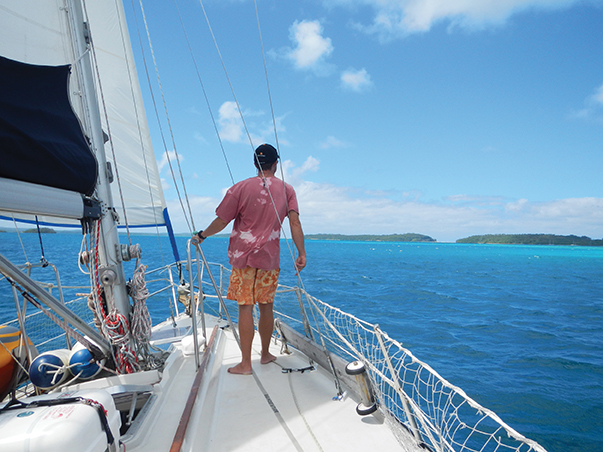Finding the best of what this beautiful island kingdom has to offer (published November 2014)
Apparently, we had it all wrong. The best thing about Tonga is not the sailing. No! The true highlight of this island kingdom is in fact, a Tongan feast. This message was continuously reinforced from the moment we cleared customs. You “Must go to a feast!” admonished cruisers who had arrived a few weeks earlier. “Come to our village feast!” called the friendly voice of a local whose community made a fund-raiser out of the event. Such offers were a regular feature on the morning cruisers’ radio net. “Have you signed up for the weekend feast?” urged neighboring sailors.
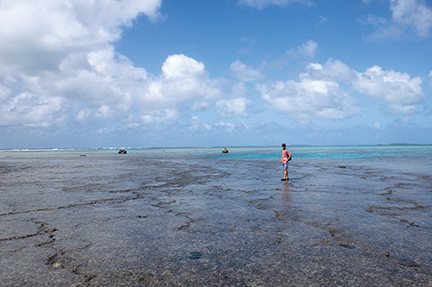
We felt a little disoriented, because we had actually come to Tonga for the sailing, not the feasting. After thousands of miles of sailing between isolated Pacific Islands, we had finally reached a compact, sheltered cruising ground. In Tonga’s northern island group, Vava’u, we looked forward to the novelty of short, frivolous day trips. Our sloop became a hyperactive beehive of activity as we tacked, winched and trimmed away. We could bask in comfortable beam reaches, kick back during placid downwind runs and thrill in windward beats—all in a single afternoon! On the menu were deep, wide channels, snaking slalom runs between islands and challenging, reef-dodging routes. We were in Tonga to feast, all right—to feast on the sailing.
Firm in our resolve to overindulge in sailing at its best, my husband, Markus, nine-year-old son Nicky, and I made a quick, two day turnaround after our arrival in Neiafu, the administrative capital of Vava’u. The next week went by in a flurry of maneuvers since no two anchorages in Vava’u, it seems, can be connected by a straight line. Our 1981 Dufour 35, Namani, romped through the watery maze like a frisky pony set loose in an aquamarine pasture, throwing in twists and turns just for the sheer joy of the movement. The route we followed on the first day traced an upside down J; day two drew an uneven letter U. Day three saw us covering a mere nine miles on a route shaped like a bent fish hook, with a downwind leg, a beam reach and finally an alpine ascent of zigzag tacks. The wind, blowing a steady Force 4 or 5, came in three flavors: northeast, east and southeast. The sky was blue, and thanks to a long line of reefs on the windward side of Vava’u, the water was flat. We were happy, relaxed and eager for more.
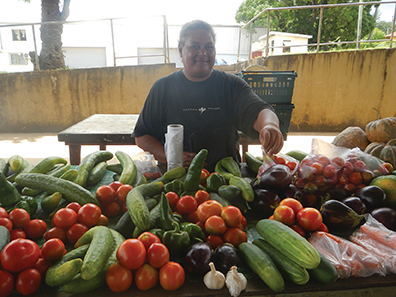
Reinforcing our emphasis on sailing was the fact that many of the established anchorages are best known by number references, due to a scheme invoked by the Moorings charter base that has (sadly) stuck, at least among the cruising community. So we zipped from anchorage number six to neighboring number seven, skipped right over to eleven and then made our way to a true gem, number thirty. Which isn’t to say that we ignored the shoreside charms of Tonga. On the contrary, we had a wonderful variety of experiences: attending a church service near Mala Island, where the congregation sang gorgeous, vowel-rich hymns at the top of their lungs; collecting our fill of ripe, juicy mangoes on a long walk from Tapana; snorkeling among plump, indigo starfish at Port Morelle; and trading colored pencils for bananas in a peaceful village on Kapa. Since education is a national priority in Tonga and English is emphasized, we were able to converse freely with locals whose lives, like ours, are defined and delineated by the water.
Our most glorious daysail in Vava’u came when we weighed anchor in Tapana and set course for Kenutu Island on the less visited eastern fringe of Vava’u—three miles as the crow flies, but 15 over the shortest water route. With tacks, Namani covered 23 miles that day as we eyeballed our way around green islets resting like so many wallowing sea turtles, each with a golden, sandy ring encircling its shell. We even found ourselves enjoying two hours of tacking into the easterly wind. Maybe all that tropical sun was getting to us, after all.
When at last the froth of the outer reef boiled just off our bow, we seized our reward and eased the sheets to fly northward on a beam reach. Markus stood at the bow, signaling a quick jog to port, then starboard as we dodged coral heads that littered the narrow channel between two spitting reefs. What a glorious sensation to sail this serpentine route without the noise of an engine or the filtering effect of a chartplotter! We were back to the basics of sailing and loving it. When at last our anchor bit the sand in the lee of uninhabited Kenutu, we felt a warm glow of accomplishment.
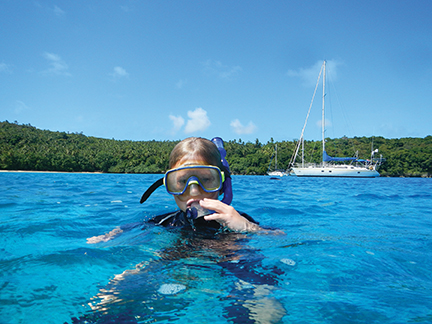
Kenutu’s location behind a gauntlet of reefs poses a selection process of sorts, and we were proud to have made the cut along with six interesting and highly accomplished crews. Two South Africans were on their way to a new life Down Under, and a Japanese couple was circling the Pacific. One family was heading home to New Zealand after a nine-year cruise to Norway via Chile, while another was about to close the loop on a “normal” four-year circumnavigation. All congregated on the beach to share sundowners, snacks and companionship. Though this wasn’t a feast in the literal sense, we savored delicious anecdotes and chased them down with scrumptious sailing stories as our driftwood campfire crackled in the sand.
Sailing back into the heart of the Vava’u group, we headed for little Lape, population 30. There, young Nicky was invited to spend a day at the one-room schoolhouse. His favorite subject? Recess, naturally. As an afterschool treat, we snorkeled on the magnificent Coral Gardens, spotting whole colonies of clownfish among the rainbow assortment of shapes. We had ticked off all the best of Vava’u in two brisk weeks, including swimming into submerged caves and braving the narrow, rocky pass into the lagoon of doughnut-shaped Hunga Island. We were ready to move on, content to have done everything. Everything, that is, except a feast.
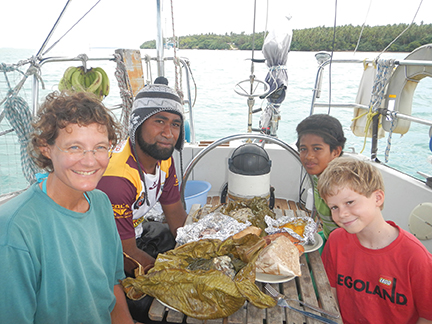
I had to ask myself: what was this obsession with feasting, anyway? Apparently, it all goes back to 1953, when Tonga’s Queen Salote attended the coronation of a young Queen Elizabeth in London. In spite of the pouring rain, Queen Salote insisted on keeping the hood of her horse-drawn carriage down throughout the long procession as a sign of respect. Salote’s symbolic gesture and winning smile earned her legions of adoring fans all over the world. When Elizabeth visited Tonga soon after, Queen Salote laid on the feast of the century. It was an open-air affair that stretched over 100 meter-long table laden with tropical fruit, roast pigs, succulent seafood and countless other leaf-wrapped goodies. Grainy black-and-white images of the feast spun to newspapers around the globe, and a legend was born.
All very nice, but as I said, we were in Tonga for the sailing. So we ventured back into open water, sailing 60 miles south to the less frequented Ha’apai group, a tangle of reefs and exposed islets that make navigation more exacting and good shelter difficult to find when weather conditions go from benign to bad. Consequently, only a fraction of the cruisers who crowd Vava’u venture into these azure waters. When we checked in with the port captain in Lifuka (a quick and easy formality), we learned that only 60 boats passed through in the peak months of September and October. That left the best of Ha’apai to a select—and scattered—fraternity of sailors. Here, we could each retreat to our respective anchorages, and a good thing, too, since many are small and only partially sheltered. All the more reason to rave about the rewards: uninhabited islands, superb snorkeling and in the right season, a better opportunity to see whales without the stampede of snorkelers these behemoths attract in Vava’u.
Like Vava’u, the Ha’apai group offers a veritable smorgasbord of post-sailing activities. In Ha’ano, giant bats hung like so many over-sized, upside-down fruit in the trees. That is, until the sound of our voices shook them into the air like a foreboding (but ultimately harmless) scene from a Hitchcock movie. Tiny Luangahu proved to be a difficult place to find shelter, but once settled in, we could circle the entire island on foot in a few minutes, or linger over the exotic seashells underfoot. Nicky, meanwhile, was in his element digging giant sand pits and collecting driftwood for a full moon campfire on our private island.
Throughout our Ha’apai sojourn, we were keenly aware of how the sailing skills and smooth teamwork we had developed over the past months were paying off. For us, the ultimate test came at O’ua, a long, thin island encapsulated by reefs. Many charts neglect to indicate the small, winding pass on the south side of the island. In fact, we had little more to go on than outdated waypoints and rumors of defunct navigational aids. This was a challenge we would never had dared attempt at the start of our journey, but now we were confident enough to give it a try (albeit ready to turn tail at a moment’s notice).
After tacking Namani boldly up to the reef’s edge, we struck the sails and motored cautiously ahead with a constant lookout on the bow. The early afternoon light lit the reef brilliantly as we scanned for any sign of a break. There it was, a crooked pole marking the entrance between two frothing shallows. We were in, drawing a wide arc to reach the deep basin that harbored a handful of other boats. They, like us, were drawn to O’ua by its promise of good shelter when a forecasted trough was to pass over the area the next day, bringing torrents of rain.
Every cloud has a silver lining, and in O’ua, this came in the sturdy form of a young local named Freddy. We were initially bewildered when this 20-something-year-old swam out to our boat at the height of a squall and perched on our stern ladder. What on earth was he up to, swimming in such weather? What did he want? His broken English and our non-existent Tongan did little to clarify the situation at first. But Markus, with his patient heart of gold, joined our visitor in the downpour, communicating through basic English and hand gestures. It was a little like navigating with paper charts, it requires some use of the brain, but ultimately gets you to your destination. Our visitor didn’t appear interested in fishing gear, nor was he particularly curious about our boat, and he certainly didn’t harbor any evil intentions. It seemed that all Freddy wanted was to initiate a little contact with the outside world, an impression confirmed later when we visited him on land. Living in an isolated island village with less than 100 crowded inhabitants has its limits. What’s a little rain when the outside world comes knocking at your door?
Little did we know that this strange encounter was to pave the way for a very unique experience. When Freddy returned the next (sunny) day with a bunch of bananas, we invited him to join us for lunch. Freddy raised his heavy eyebrows in the Tongan equivalent of a nod and lingered over every bite of freshly baked bread and canned ham as if they were gourmet treats. Then he promised to return the next day with a feast for us. Now it was our turn to raise our eyebrows and nod. This, we had to see.
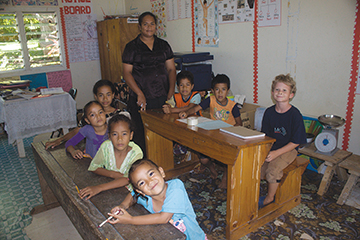
True to his word, Freddy appeared the next day on a borrowed skiff and stepped aboard Namani with his promised feast; Tongan take-out, as Markus later quipped. The meal had been cooking in an umu, or earth oven, for hours, and was now spread across our cockpit table in succulent, leaf-wrapped packages. Each dish came with a deceptively Spartan title that belied the explosion of flavors it promised. “Fish” referred to three steaming, juicy reef fish marinated in coconut milk; “chicken” was the unassuming name of a deliciously soft, steamed meat; accompanying them were octopus, taro and cassava, plus fresh-off-the-tree papaya for dessert. It was a feast fit for a queen and a day to remember. Freddy borrowed Markus’ guitar to strum a few tunes while his son Anis joined Nicky in climbing the rigging and tinkering with Legos. Among the many facts we gleaned from Freddy that day was that secondary education is much harder to obtain in the Ha’apai group, explaining why fewer people had the same mastery of English that we observed in Vava’u. No matter, friendships can be made with or without language. With few words yet generous gestures, Freddy left a lasting impression.
Our time in Tonga was not yet over, but we knew there would be no topping this high. Weighing anchor the next day, we bid a sad goodbye to our friend, hoping he would find many new acquaintances among other cruisers who passed O’ua—few that they might be. How pleased we were to have made the journey not only to Ha’apai, but to Freddy’s doorstep. Tonga had provided us with a feast for the senses, and we could indulge no more. After clearing out in the kingdom’s capital, Tongatapu, 60 miles south, we headed out to sea once again, our eyes fixed on Minerva Reef and Opua, New Zealand. A season of unforgettable Pacific experiences—and unlikely friendships—was drawing to a close.
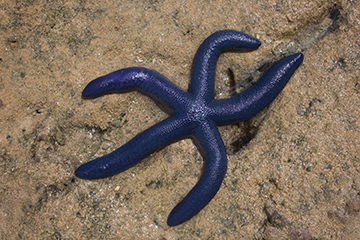
Nadine Slavinski is the author of Lesson Plans Ahoy: Hands-On Learning for Sailing Children and Home Schooling Sailors. Together with her husband and young son, she cruised the Atlantic and Pacific aboard her 1981 Dufour 35, Namani. She is currently at work on The Silver Spider, a novel of sailing and suspense, as well as Pacific Crossing Notes: A Sailor’s Guide to the Coconut Milk Run (see nslavinski.com for more information and free resources on home schooling).

















